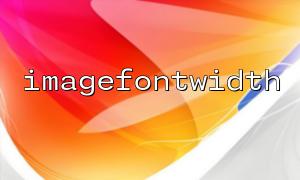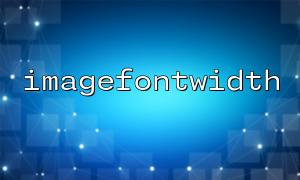Imagefontwidth() is a relatively basic but very practical function when using PHP's GD library for image processing. It is usually used with functions such as imagestring() to accurately control the layout of text on images. Understanding the return value of imagefontwidth() helps us calculate the width of the text more accurately when dynamically generating images, avoiding the problem of text exceeding the boundary or typography confusion.
imagefontwidth() is a function in the PHP GD library that takes a parameter - the font size (or font identifier), returning the horizontal pixel width of each character in the font. The return value of this function is an integer representing the width (in pixels) of any character in the font.
$width = imagefontwidth(5);
echo $width; // Output a font number 5 Character width
The parameters used in imagefontwidth() are not arbitrary, but rather a set of predefined font identifiers provided by PHP. They are usually integers, from 1 to 5, corresponding to built-in fixed-width fonts:
1 : Minimal font, narrow width
2 : A little bigger
3 : Medium size
4 : Slightly larger
5 : The largest built-in font
For example, if you are using the font identifier 1, then imagefontwidth(1) may return 5, meaning that each character is 5 pixels wide; if it is the font identifier 5, it may return 9, indicating that each character occupies 9 pixels wide.
The return value is an integer representing the pixel width occupied by the character in the horizontal direction. That is, if you want to draw a string of characters on a picture, for example:
$text = "Hello, World!";
Then you can calculate the overall width of the string of characters in the following way:
$font = 5;
$width = imagefontwidth($font) * strlen($text);
This width can help you:
Center-align text : You can get the starting horizontal coordinate of the text by subtracting the text width by dividing it by two.
Determine whether text will overflow boundaries : You can judge whether shortening or line-breaking text needs to be based on the image width.
Implement precise positioning : This value is very critical for image layouts with high pixel level requirements.
Suppose you need to center the text on an image with a width of 200 pixels:
$text = "Hello";
$font = 3;
$image = imagecreate(200, 50);
$bg = imagecolorallocate($image, 255, 255, 255);
$text_color = imagecolorallocate($image, 0, 0, 0);
$text_width = imagefontwidth($font) * strlen($text);
$x = (200 - $text_width) / 2;
$y = 20;
imagestring($image, $font, $x, $y, $text, $text_color);
imagepng($image, 'output.png');
imagedestroy($image);
In this example, we use imagefontwidth() to get the width of each character, and then multiply it by the total number of characters to calculate the pixel width of the entire text, thereby realizing the centered display.
imagefontwidth() only works with built-in fonts. For the TrueType font used by imagettftext() , the width calculation needs to be calculated using imagettfbbox() .
The return value is affected by the font number, which does not support custom fonts by itself.














